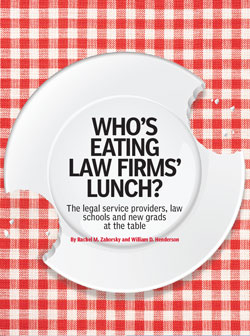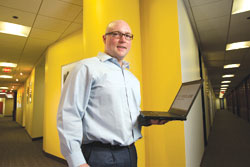Who's eating law firms' lunch?

Illustration by Manzo/Shutterstock
Deanna Johnston had 30 minutes to spare. As vice president of litigation at Fireman’s Fund Insurance Co., she and her busy team couldn’t afford to waste time meeting with another typical legal vendor. But her boss, the general counsel, had insisted on this one.
Two hours later, Johnston hired the company to aid her outside counsel on a test basis to redo the discovery process: roughly 30,000 documents for a case two months before trial. The vendor’s team of lawyers identified a missing key document and saved Johnston $100,000 in outside lawyers’ fees on the matter—even as she paid for repeat work—because the high level of organization and analysis of the thousands of documents so thoroughly and quickly prepped her team and the BigLaw lawyers for trial.
To date, Johnston says her relationship with Novus Law, the legal services company based in Chicago, has saved her an estimated 15 to 30 percent per case on outside counsel fees. With a single matter running Johnston nearly $3 million, the dollar amount saved is substantial.
“They’ve become valued litigation partners; I don’t view them as a vendor,” Johnston says. “They’re better than any contract review attorney and most junior associates, even at well-known firms. When you add in the pricing, it’s an overall great value.”
Johnston isn’t the only corporate client seeking alternative legal service providers and partnerships over the sole reliance on traditional firms—at a hefty swipe at those firms’ bottom lines. In fact in 2012, Novus Law claims, it saved another of its corporate clients nearly $3 for every dollar spent on work originally tasked to another firm. For every $3 it saved the client, Novus Law earned $1 in fees.
That means the client’s law firm lost $4 for every dollar paid to Novus Law.
Or look at it this way: 2012 revenue for the top 100 U.S. firms totaled more than $70 billion, according to American Lawyer magazine. Since the recession hit the legal profession in 2007, these firms have grown in headcount, often through mergers and the absorption of lawyers from several law firm failures. But on a per-lawyer basis, revenue has been essentially flat.
Novus Law, by contrast, is tripling its revenue year over year. And as Novus and many other legal vendors snatch millions of dollars in work typically done by traditional law firms, the growth of the Am Law 100 could disappear completely.

Novus Law: Joe Kelly, Joanna Penn, Ray Bayley, Lois Haubold and Jerry Carter. Formed eight years ago, this Chicago-based legal services provider competes as well as partners with top law firms across the country. “What Novus does,” notes Akin Gump litigation partner Shawn Hanson, “is return lawyers to being lawyers. Our younger lawyers are much more free with Novus, used thoughtfully and properly in real collaboration, to do what’s great about being a lawyer.” Photo by Wayne Slezak.
Nearly 80 percent of the work done by Novus Law attorneys is work large law firms would otherwise do, according to co-founders Ray Bayley and Lois Haubold. It reviews, manages and analyzes documents for large-scale litigation, and is poised to focus its technology and resources on drafting briefs and motions.
One should note that neither is a lawyer. Bayley served as managing partner of PricewaterhouseCoopers’ North American business process outsourcing organization and sat on PwC’s U.S. management committee; Haubold also was a PwC senior executive. Together they’ve launched and run several different entrepreneurial ventures and professional service firms. They are efficient and accurate masters of process.
“For the Fortune 500, we determined that somewhere between $40 billion to $50 billion a year is spent on work that we do,” says Bayley, whose lawyers focus on complex litigation, which funnels in more dollars than any other aspect of the legal profession. Bayley contends that it’s also the most inefficient area.
“More than half of that money is wasted on non-value-added spend,” he notes.
“The legal profession focuses on inputs, number of people, hours and so forth, which is important if your revenue is driven by the billable hour,” Bayley says. “Our model is based on outputs—how much we can produce in a given period of time while minimizing the cost of inputs and achieving world-class levels of quality.”
To that end, client engagements are priced on a predictable budget, defect-free work product and timely delivery. The Novus One-Touch work process was part of the first-ever quality management system independently certified by the Underwriters Laboratories for use in the legal profession. In 2008, this resulted in Novus Law becoming the first nonlaw firm to win the InnovAction Award from the College of Law Practice Management.
Bayley and other legal service providers (some who’ve traditionally performed services for law firms, many who now deliver services in competition with them) who embrace technology and design and apply a scientific, process-driven methodology to this type of legal work offer an estimated $25 billion savings opportunity for corporate America, he says.
With numbers like that, other legal service providers and new entrepreneurs aren’t just eating BigLaw’s lunch; they are eyeing breakfast and dinner as well. Most of this change has occurred under the radar as these new legal entrepreneurs started with so-called commodity legal work like document review. But why would they stop there?

Oliver Goodenough: “A technology-driven revolution is overturning how America practices law.” Photo by Arnold Adler.
VISIONS OF THE FUTURE NOW
While on his usual pilgrimage to the LegalTech New York show in January, Vermont Law School professor Oliver Goodenough had an epiphany. In prior years he had been fascinated by the more than 200 competing vendors, which he viewed as legal support. But as he surveyed what he estimated to be $20 billion to $30 billion a year in commercial activity this winter, Goodenough says he realized that “this activity is legal work.”
The companies appearing at LegalTech represent the next step in an evolution that originally produced large corporate law firms, Goodenough says. Those firms hit a hiring plateau as early as 2004. A data set called County Business Patterns, assembled and published by the U.S. Census Bureau, has the statistics.
In the category known as Offices of Lawyers, total employment in law offices peaked in 2004 and thereafter has declined by more than 50,000 as of March 2011. Between 2008 and 2011, total law office payroll has been completely flat at $88 billion.
The category of All Other Legal Services was less than 1 percent of total legal services employment in 1998, but by 2010 had more than doubled to beyond 21,000 jobs—an annual growth rate of more than 6 percent. It now makes up nearly 2 percent of total legal industry employment.
Indeed, walking the floors of LegalTech revealed a burgeoning legal industry that included not only services but also products. We did some number-crunching for the 227 exhibitors at the 2013 show:
• 35 percent were offering services.
• 49 percent were offering products.
• 13 percent were offering both.
The primary product offering was software, typically to make legal work better, faster, cheaper or all three. Yet companies that make legal products such as software are unlikely to be included in the County Business Patterns census of the legal service employers. This suggests the boundaries of the legal industry are beginning to blur.
One thing is for sure—technology and law are the wave of the future.
This tech-driven approach to law is the growth area being targeted by some law schools and professors, ones like Vermont and Goodenough.
Goodenough expands on his LegalTech epiphany in a recently published Chicago-Kent Law Review article, noting that the traditional law firm “is no longer the best game in town for delivering high-quality legal service through scaling and flexibility. Rather, we are developing even more concentrated engines of efficiency and scale, often technologically enabled, in the new service companies like those on the floor of LegalTech. “Legal practice isn’t going away,” he continues. “It is just going to forms of delivery that can combine the competence and flexibility of an old-fashioned firm with the efficiency and scale of a just-in-time cloud-computing company.”
WHERE THE JOBS ARE
That prediction may cause night sweats and denial among some longtime legal practitioners, but it’s proven in the growing lists of legal services and product providers that are not law firms and the market share they are now vying for. It is also changing how hiring is done by these legal-not-law firms, and how some bright students are plotting their careers in law.
This past year, Goodenough negotiated with the trade show organizers to obtain discounted floor passes for some of his students. Of the eight students from his e-lawyering class who carpooled to Manhattan, three left the show with job interviews. One has already landed a job. (Remember, LegalTech is a trade show, not a job fair. )

Photo of Jerry Carter by Wayne Slezak.
While nearly half of recent law school graduates have yet to find jobs requiring a law degree, law students with technical training are finding themselves in demand.
Jerry Carter is a 34-year-old graduate of Indiana University’s Maurer School of Law who recently joined Novus Law. A self-described middle-of-the-class student, Carter lacked the pedigree to gain notice by most high-end corporate law firms. However, because of his prelaw business and financial career, plus stints with Korean, Indian and Japanese law firms, the JD and MBA grad fielded (and eventually turned down) offers from foreign law firms, banking giants and U.S. hedge funds.
“Going into a law firm, you see an unbelievable amount of inefficiency,” Carter says. “At the firm in Korea, I’d be sent a text: ‘Jerry, check your email,’ and it would be 12 hours of work due in eight. Two other people may have already looked at it, but I had no idea of value added or the redundancy of work being done.
“I want to educate companies paying too much for legal services on a daily basis,” he says, “and continue innovation in this emerging market.”
According to Bayley, Carter is an ideal entry-level hire for Novus Law, which Bayley says offers new recruits significantly higher salaries than the $60,000 median published by NALP for 2011 law graduates.
“Jerry has prelaw work experience at Toyota, where he learned Six Sigma and lean manufacturing,” Bayley says. “These are the same concepts and principles we apply to our legal work. Our entire business is organized around structured process management and quality control.”
The company also scooped up two other recent law grads: IU Law-trained Joanna Penn, 29, a former media relations coordinator in New York City and copywriter in China, and Joe Kelly, 31, who before attending Michigan State University College of Law worked as a computer programmer at a prominent media and technology company.
Kelly transmitted a copy of his law school transcript to his new employers, but no one at Novus Law cared. “Having top grades was just not relevant to our hiring decision,” says Bayley. “We wanted Joe for his interdisciplinary skills and passion for innovation.”
At MSU Law, Kelly experimented with data visualization in cutting-edge projects involving real-world data for external clients as part of the school’s ReInvent Law Laboratory, the brainchild of law professors Daniel Martin Katz and Renee Newman Knake. (See “Legal Rebels—A Banner Year,” September, page 33.)
Bayley visited Katz’s quantitative methods class (part of the laboratory coursework), which he describes as “core to measuring and monitoring Novus Law’s work process and continuously improving quality.” Bayley’s team also committed to an annual recruiting trip to East Lansing, which fits with Katz’s long-term plan to place up to 25 students a year from his ReInvent Law Lab into the burgeoning law and technology field—almost 10 percent of each year’s graduating class.
Katz, an untenured junior professor, is betting his career on a massive technology and process-driven tidal wave that will fundamentally transform the legal profession and, thereby, legal education. And others are betting on him too.
In 2012, the Ewing Marion Kauffman Foundation, which specializes in entrepreneurship and education, supported Katz and Knake’s program—which proffers the tagline Law, Tech, Design, Delivery—with a $150,000 grant.
The transition can also be observed through the careers of some of Goodenough’s students from the early ’90s who are now reaching midcareer. Kevin Colangelo, a ’94 grad of Vermont Law School, is a New York City lawyer who worked at several large law firms and co-chaired the outsourcing and technology transactions practice at Am Law 100 firm Kramer Levin Naftalis & Frankel.

Kevin Colangelo: “Once you thought about it, there was no principled reason why this pattern was going to exempt BigLaw.” Photo by Arnold Adler.
“All of the lawyers in my area of practice observed the same relentless pattern of businesses gaining enormous efficiencies through technology and globalization; albeit the collateral effects were often massive employment dislocation,” Colangelo says. “Once you thought about it, there was no principled reason why this pattern was going to exempt BigLaw.”
To pre-empt the eventual outsourcing of his own career, Colangelo did something in 2006 that baffled his peers. He applied for a job as a business development manager for a fledgling legal process outsourcer called Pangea3.
The primary appeal was not the business model itself, but Colangelo’s firsthand knowledge of Pangea3 co-CEO David Perla. During the early 2000s, Perla and Colangelo had been opposing counsel on a major mergers and acquisitions deal when Perla was general counsel at Monster.com. After the deal closed, the two became friends. A few years later, Perla also did the unthinkable and left the security of his high-profile job to start Pangea3.
Some may believe that if a paradigm shift is in the offing, it is only in the beginning stages. But if you look at the careers of Perla and co-founder Sanjay Kamlani, the shift is at least 10 years in the making. And their formative life experiences date back even further.
The duo were classmates at the University of Pennsylvania Law School in the early 1990s and after graduation, Kamlani served as Perla’s tour guide on a leisure trip to India. Thereafter, they began what Perla called “parallel careers.” Kamlani developed and managed PwC’s India International Business Network and later became general counsel of OfficeTiger, one of the first companies at the center of the burgeoning industry of business process outsourcing. Perla joined Katten Muchin Zavis Rosenman.
When, at a 2003 dinner, Perla expressed his dissatisfaction with the limited menu of options for obtaining better and cheaper legal services, the two wondered whether the principles of outsourcing could disrupt and improve the staid U.S. corporate market.
Seven years later, they sold the resulting outsourcing venture, Pangea3, to Thomson Reuters in a deal a source close to it assured us was valued at nearly $100 million.
WHAT NEW EMPLOYERS?
Looking at the County Business Patterns data set, a question arises: What employers make up the rapidly growing All Other Legal Services sector? While there is no definitive answer, we have many clues.
The Census Bureau aggregates payroll and headcount data to preserve the anonymity of companies. Yet the state-level data reveals surprising statistics: Delaware, Florida, Georgia, Missouri, New York, Ohio and Pennsylvania all have at least one All Other Legal Services employer with 500 to 999 employees. Of those with 100 to 499 employees, California has eight such employers; Florida, Illinois and Texas have two; and Connecticut, Indiana, Massachusetts, Minnesota, New Jersey, Ohio and Pennsylvania each have one.
Ron Friedmann, a law and technology consultant and former legal process outsourcing executive, helped generate a list of large alternative legal service providers now posted at ABAJournal.com. The majority of companies fell into three relatively blurry categories:
• Companies assembling teams for document review or other specialized legal projects.
• Legal process outsourcers, typically involving foreign labor.
• Companies specializing in predictive coding and other solutions involving technology and machine learning.
These companies also share one significant trait: As opposed to U.S. law firms, they all invite nonlawyer financing.
In the document review space, major players include Robert Half Legal, a division of Robert Half International, which is publicly traded on the New York Stock Exchange (ticker symbol: RHI); and Special Counsel, which has 36 U.S. locations and is owned by Adecco Group North America, a subsidiary of the Adecco Group, which is traded on the SIX Swiss Exchange (ticker symbol: ADEN).
Some domestic document review work, however, can be diverted to legal process outsourcers. LPO competitors include Pangea3 (now owned by Thomson Reuters, NYSE symbol: TRI); Huron Consulting Group (Nasdaq symbol: HURN); CPA Global (owned by a European private equity firm); Integreon (majority-owned by two international private equity firms); and UnitedLex (financed by venture capital funds, including Sequoia Capital).
However, a substantial portion of the LPO work may soon be eclipsed by more sophisticated computer algorithms in a category broadly referred to as predictive coding. Companies that specialize in predictive coding include Recommind, which was formed in 2000 and now has more than 100 employees in six locations spanning three continents, and Kroll Ontrack, which started in the hard-disk recovery business in the 1980s and now employs more than 1,500 workers in the U.S., Europe, Asia and Australia. The latter is owned by Kroll Inc., a subsidiary of Altegrity—a conglomerate that specializes in information technology and analytics. The Altegrity group of companies is principally owned by Providence Equity Partners, a private equity firm with more than $27 billion under management.

Bryce Arrowood and Mark Cohen—Clearspire’s co-founders plan to raise an additional $3 million from outside investors this year. Photo by Arnold Adler.
One part law firm and one part business entity, Washington, D.C.-based Clearspire Law Co. aims to expand its nontraditional law firm model across the country with the addition of 50 to 100 BigLaw lawyers each year for the next five years, all serviced by its sister business outsourcing company, Clearspire Services Co. Together they make up the legal service business Clearspire.
Co-founders Bryce Arrowood, who previously built one of the first temporary legal staffing firms in the U.S., and civil trial lawyer Mark A. Cohen, an early adopter of information technology in the delivery of legal services, started the company in response to the sea change expedited by the Great Recession.
“We looked at the state of play, and for the first time law firms were not experiencing the year-to-year explosive growth they had seen,” Cohen says. “We had to come up with a novel way to inject business process methodologies into legal services, to move the focus away from [profits per partner] and allow the firm to operate as a unified entity while outsourcing all of the business operations and support services to its sister company.”
In addition, the duo spent $5 million of their own funds to build the online platform Coral, which connects lawyers and clients through virtual offices and high-end videoconferencing. Their efforts have garnered the attention of more than 200 general counsel of Fortune 500 companies in the past two years.
“I don’t think any law firm I can think of has that kind of access to that high level of corporate America,” Cohen says. “And the reason for it is clearly not solely the fact that we have a whiz-bang group of lawyers and are growing nicely. Rather, it’s that this platform is a game changer.”
The two-company model, along with the cutting-edge technology of Coral, strips away many of the overhead cost escalators of large law firms, driving efficiency, Cohen says. It also allows for nonlawyer investment and revenue-sharing in Clearspire’s business arm, which doesn’t operate under the restrictions of ABA Model Rule 5.4: Professional Independence of a Lawyer. As a result, the company plans to raise $3 million from outside investors this year.
PROFS IN THE GAP
Not surprisingly, many of the companies mentioned above were vendors on display at the New York LegalTech show in January. To the dismay of Goodenough, one seemingly important group was missing: law professors.
“This disconnect is striking,” Goodenough observes. “A technology-driven revolution is overturning how America practices law, runs its government and dispenses justice. The revolution has so far gone almost completely unnoticed by the people who teach aspiring lawyers. This has to change.”
Goodenough began his legal career in the late 1970s as an associate in a major New York City law firm and, a few years later, lateraled to a small boutique where he became partner. In the early 1990s, when Goodenough started his legal academic career, he was nearly 40 and arguably had too much practice experience to be taken seriously by law faculty. Nonetheless, Vermont was willing to give him a shot. During the subsequent two decades, Goodenough’s research has probed the intersections of law, economics, finance, media, technology, behavioral biology and neuroscience, winning several academic awards and distinctions along the way.
Goodenough’s story makes a simple, yet distinct point—we should use caution when tempted to casually disregard the observations of someone who has achieved success as both a practicing lawyer and an academic scholar. If anyone in the legal profession has the experience and credibility to call a paradigm shift, it’s Goodenough.
For the past two years, MSU’s Katz was the only full-time law professor who spoke at the LegalTech conference. Katz and Knake are creating a curriculum relevant to the emerging law and technology sector, albeit primarily for companies like Novus Law and Recommind, whose competitive advantage is rooted in process and technology.
Within the legal academy, Katz is an anomaly. Aside from his JD, he has a PhD in political science and public policy from the University of Michigan. However, he focused almost all of his graduate study on complex systems. It’s a relatively new scientific field that uses mathematical modeling to understand how a multitude of human and nonhuman factors interact and influence one another. Human society and the human brain are two examples of complex systems. Neither can be effectively modeled by conventional math or statistics.
The late Larry Ribstein at the University of Illinois was one of Katz’s early mentors. When he went into teaching a few years ago, Katz says, Ribstein told him: “I bet you must feel like an alien. I greatly admire your work. You are definitely on the right track. But the rest of the legal academy is just not ready for you.”
In June 2011, Katz joined the faculty at MSU Law. Michigan State partnered with the Detroit College of Law in 1995 and moved the law college into a building in East Lansing two years later. Though the school’s rebranding efforts did raise its profile, to most of the profession, MSU Law remains a nonprestigious regional law school located in the heart of the Rust Belt.
None of this dissuades Katz from his sincere belief that it is possible to turn any institution into the preferred recruiting grounds for the nation’s emerging law-and-tech industry.
“When I was 18 years old,” explains Katz, “I had the privilege of joining a transformative organization”—as a kicker for the University of Oregon football team, the Ducks. “We were in the Pac-10, but it’s in Eugene, Ore., where it is often cloudy and raining. We had no shot at all with the top recruits from Southern California. So coach Mike Bellotti had to figure out ways to stretch and optimize what some might call second-tier talent.
“Oregon is now a national powerhouse, but the seeds of that success were sown much earlier. It was difficult to be bigger or faster than USC or UCLA. So Coach Bellotti decided we would be better on the details of the game. We would be better conditioned and we would pay significant attention to special teams. Our emphasis on special teams got us better field position. And by the third or fourth quarters, our opponents would have their hands on their burning legs. But because of our conditioning regimen, we had more stamina. Our success became contagious. Over time, we were able to get prized recruits. It was a culture of innovation.”
During Bellotti’s tenure at Oregon, from 1995 to 2008, the Ducks had only one losing season, blotting out decades of mediocre performance. The year that Katz graduated, the Ducks were co-champions of the Pac-10, a feat that makes him beam with pride.
Katz’s “secret sauce” for ReInvent Law is arguably much more important than a degree in complex systems. He looks at the 25 students entering the ReInvent Law Laboratory as raw human potential. Katz also actively recruits potential law school applicants to his program, though he declines to discuss his strategy.
Katz understands that the most attractive candidates for the law and technology sector are those with special skills that are often obtained through prelaw work experience. “But there is no reason why some of those key skills and experiences cannot be learned and obtained right here,” Katz says of the MSU program.
He notes that virtually all law students have high cognitive ability. He feels the key to their future success is mastery of domain-specific knowledge—often in areas that are complementary to law—and the ability to collaborate across disciplines. This requires engagement and an immense amount of time spent on the task. So how does one develop the educational program that will prepare the law student for legal-tech jobs—some that may not yet exist?
“This,” Katz says, “is just an education design problem.”
Sidebar
Seated at the Table
There are some prominent names already feasting on duties formerly done by law firms, including:
Source: JPMP Consulting Inc.William D. Henderson is director of the Center on the Global Legal Profession and a professor and Nolan Faculty Fellow at Indiana University’s Maurer School of Law. Rachel M. Zahorsky, who was a legal affairs reporter for the ABA Journal at the time this story was written, accepted a position at Novus Law as this issue was going to press.



